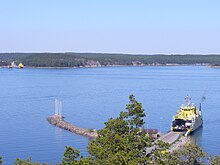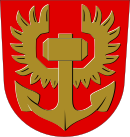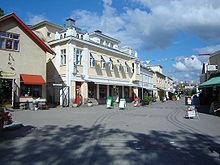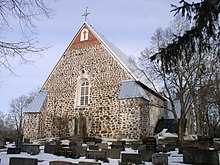Pargas
| coat of arms | map |
|---|---|

|

|
| Basic data | |
| State : |
|
| Landscape : | Varsinais-Suomi |
| Administrative community : | Åboland |
| Geographical location | 60 ° 18 ′ N , 22 ° 18 ′ E |
| Surface: | 5,548.48 km² |
| of which land area: | 881.87 km² |
| of which inland waterways: | 7.29 km² |
| of which sea area: | 4,659.32 km² |
| Residents : | 15,217 (Dec. 31, 2018) |
| Population density : | 17.3 in / km² |
| Municipality number : | 445 |
| Language (s) : | Swedish , Finnish |
| Website : | pargas.fi |
Pargas ( Swedish ), Finnish Parainen (2009 to 2011 Väståboland or Länsi-Turunmaa ) is a city in southwestern Finland with 15,217 inhabitants (as of December 31, 2018). It lies in the archipelago off the coast of the Varsinais-Suomi landscape and, in addition to the actual core city, includes an extensive archipelago area . In its current form, the large commune came into being when the city of Pargas merged with the municipalities of Nagu , Korpo , Houtskär and Iniö to form Väståboland at the beginning of 2009 . This was renamed back to Pargas in early 2012. Around 60% of the population are Finland-Swedes . The city is officially bilingual with Swedish as the majority and Finnish as the minority language.
geography
Pargas is located in the archipelago off the southwest coast of Finland and belongs to the Varsinais-Suomi landscape. The city center of Pargas is 23 kilometers from the city of Turku . In addition to the core city, which is located in the far east of Pargas, not far from the mainland, the administrative urban area includes the entire western part of the Åboland region in the southern part of the archipelago and extends over an extensive area with over 10,000 archipelago and cliffs. The largest west-east and north-south expansion is around 75 kilometers each. In total, Pargas has an area of 1877.9 square kilometers. Excluding the marine areas, there are 868.6 square kilometers.
The Pargas archipelago can be divided into the inner archipelago in the north and the outer archipelago in the south. In the inner archipelago, the islands are larger and only separated by narrow gullies, while the outer archipelago consists of barren cliffs on the high seas. On the island of Utö in the outer archipelago of Pargas is the southernmost settlement in Finland that is inhabited all year round.
The largest islands of Pargas are Storlandet (72 square kilometers), Ålön (70 square kilometers), Kyrklandet (64 square kilometers), Kirjalaön (49 square kilometers), Lillandet (38 square kilometers), Stortervolandet (37 square kilometers), Lemlax (34 square kilometers), Huvudlandet ( 31 square kilometers), Attu (20 square kilometers), Norrskata (15 square kilometers), Kirjais (10 square kilometers) and Keisitö (10 square kilometers). The most important settlements are the core town of Pargas on Ålön, the parish villages of Nagu on Storlandet, Korpo on Kyrklandet and Houtskär on Huvudlandet and Norrby, the parish of the former municipality of Iniö.
history

During the Iron Age, the Pargas archipelago was sparsely populated by Finns who lived from fishing and seal hunting. Between the 12th and 14th centuries, agricultural Swedish immigrants settled in the area, displacing the Finnish population. At the same time, the Pargas area was incorporated into the Swedish Empire and church administration. The first parish of Pargas was founded at the beginning of the 13th century, followed by the establishment of the parish of Korpo around 1300 . Nagu was probably elevated to a chapel parish of Pargas at the beginning of the 14th century and then to an independent parish towards the end of the same century. In 1554, Houtskär was mentioned for the first time as a chapel community of Korpo and Iniö as a chapel community of Taivassalo . These two parishes only became independent in 1865 and 1908, respectively.
In 1948 the Pargas community center was elevated to a market town ( köping / kauppala ) and detached from the surrounding rural community Pargas . In 1967 the rural community reunited with the market town, ten years later Pargas received town charter. At the beginning of 2009 Pargas, Nagu, Korpo, Houtskär and Iniö merged to form the city of Väståboland. Pargas , Gullkrona , Berghamn and Havskrona were among the names in discussion for the new city . Ultimately, as the name was Väståboland set, although the language cultivation spoke out responsible in Finland spoken languages Research Institute for the Languages of Finland against this perceived as artificial name. At the beginning of 2012 the name of the city was changed back to Pargas .
population
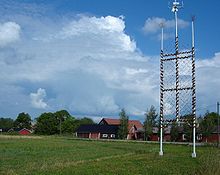
The city of Pargas has 15,217 inhabitants (as of December 31, 2018). The population density is 17.6 inhabitants per square kilometer. Four fifths of the population live in the former urban area of Pargas before the municipal merger, which belongs to the Turku catchment area. In contrast, the remote archipelago in the west is only sparsely populated. There are only four inhabitants per square kilometer in the former municipality of Iniö.
The Åboland region in the southern part of the archipelago is traditionally part of the settlement area of the Finnish Swedes . Due to the immigration of people from other parts of Finland, there is also a large Finnish-speaking population in Pargas today. 57.3% of the population speak Swedish , 41.1% Finnish as their mother tongue (as of 2010). The Finnish-Swedish population is significantly higher in the archipelago in the west than in the eastern urban area. Pargas is officially bilingual with Swedish as the majority and Finnish as the minority language.
politics
The strongest political force in Pargas is the Swedish People's Party , the traditional political representation of the Finland-Swedes. In the 2008 local elections it received over half of the votes and thus has an absolute majority in the city council, the highest decision-making body for local affairs, with 24 out of 43 seats. In previous local elections, the Swedish People's Party was even able to unite all votes in the former municipalities of Houtskär, Iniö and Korpo. Also represented on Pargas City Council are the Social Democrats with eight, the conservative National Collection Party with five and the Center Party , the Green Bund and the Left Alliance with two members each.
| Political party | Election result | Seats |
|---|---|---|
| Swedish People's Party | 51.9% | 24 |
| Social democrats | 18.0% | 8th |
| Collection party | 12.3% | 5 |
| Center Party | 6.1% | 2 |
| Green covenant | 4.7% | 2 |
| Left alliance | 4.2% | 2 |
coat of arms
The city of Pargas has had the coat of arms of the former Nagu municipality since the municipal merger in 2009. It was designed in 1958 by the heraldist Gustaf von Numers . The blazon reads: "In the red shield a silver anchor with a golden crown ". The anchor refers to seafaring in the archipelago, the crown to the Gullkronafjärd Strait.
Before 2009 Pargas had a different coat of arms. It was also designed by Gustaf von Numers and adopted in 1961. The blazon reads: “In the red shield a winged miner's hammer, the shaft of which forms the lower part of an anchor with tips, all in gold”. The anchor refers to seafaring, the miner's hammer to the quarry in Pargas. Red and gold are the heraldic colors of the Varsinais-Suomi landscape.
Economy and Infrastructure
The largest limestone quarry in Finland is located in Pargas, as well as one of the largest lime processing companies in the world called Nordkalk . In addition, thanks to the archipelago landscape, summer tourism is an important economic factor. Of all Finnish municipalities, Pargas has the largest number of holiday homes ( mökki ) with over 8,000 . Ten boat harbors and 20 smaller moorings are available for sailors.
Pargas is connected to the transport network via a total of twelve bridges, eight free road ferries and ten connecting ferries. The archipelago of Pargas is interconnected by the archipelago ring road. Pargas city center is accessible from the mainland via three bridges. Ferries run to the other islands. There is also a ferry connection from Galtby in Korpo from Ålandstrafik via Kökar to Långnäs in Åland .
Culture and sights
In addition to the nature of the archipelago, the sights of Pargas include the old town called Gamla Malmen or Vanha Malmi ("Old Market") with its pedestrian zone and picturesque wooden houses. To the east of Pargas is Qvidja , the oldest preserved manor in Finland and one of the few preserved medieval noble castles in the country. Also of historical interest is the island of Själö (Seili), which served as a place of exile for lepers from around 1620 to 1785 . Until 1962 the mentally handicapped were accommodated in the hospital in Själö. Today the island is home to a research station for the University of Turku . The oldest lighthouse in Finland is on the island of Utö (built in 1814).
There are nine church buildings in Pargas. The oldest buildings in Pargas are the three medieval stone churches in Pargas , Nagu and Korpo , each from the mid-15th century. There are two wooden churches on the islands of Själö and Nötö: the Själö church was built in 1733, the Nötö church dates from 1756–57. Iniö Church was built of stone between 1797 and 1800 and is named after the Swedish Princess Sophie Wilhelmine . On the island of Jurmo there is a chapel from 1846. The church of Norrskata (1933) and the chapel on the island of Aspö (1955–56) are more recent.
Sons and daughters
- Aimo Aaltonen (1906–1987), communist politician
- Petri Kotwica (* 1964), film director and screenwriter
- Anna Westerlund (* 1989), soccer player
- Volmar Wikström (1889–1957), wrestler
Individual evidence
- ↑ Maanmittauslaitos (Finnish land surveying office): Suomen pinta-alat kunnittain January 1, 2010 (PDF; 199 kB)
- ↑ Statistical Office Finland: Table 11ra - Key figures on population by region, 1990-2018
- ↑ Helsingin Sanomat : Länsi-Turunmaan uusi nimi on Parainen, September 6, 2011.
- ↑ Tilastokeskus / Statistics Centers (Finnish Statistics Office) ( Page no longer available , search in web archives ) Info: The link was automatically marked as defective. Please check the link according to the instructions and then remove this notice.
- ↑ Finnish Ministry of Justice: Result of the 2008 local elections
- ^ Website of the city of Pargas: Yleistietoa kunnasta.
